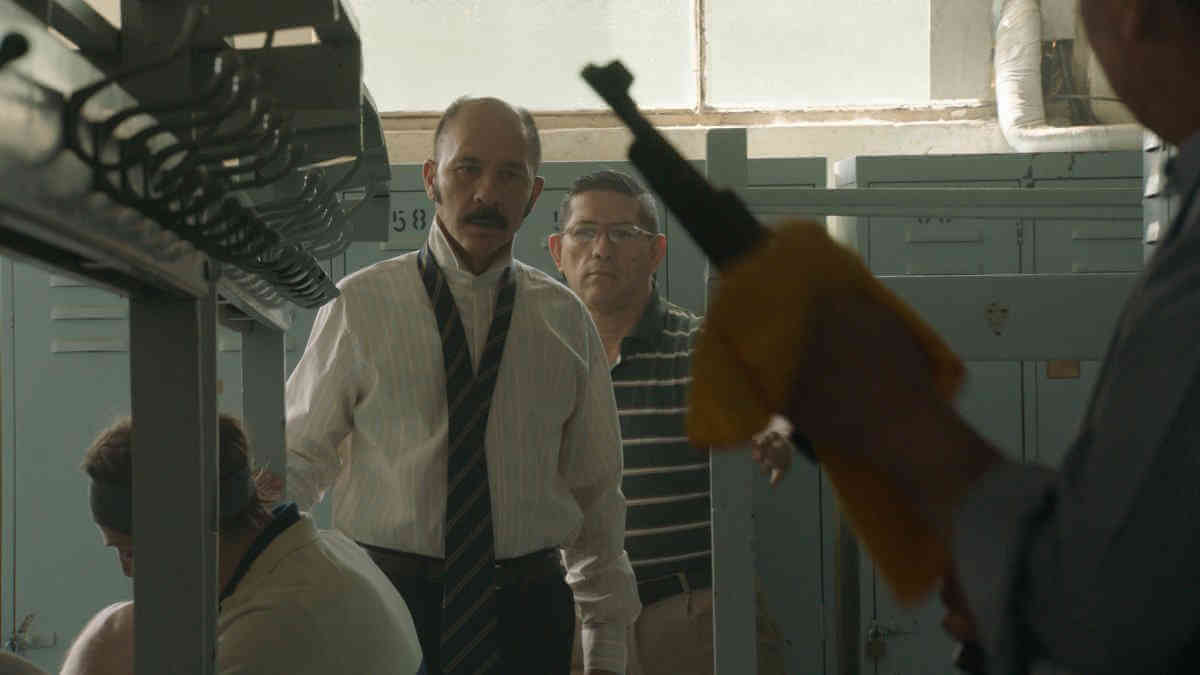Having seen two of Argentine director Benjamin Naishtat’s three films, it’s clear that his main preoccupation is the seductive nature of fascism. His 2015 film “El Movimiento” found the roots of Latin America’s corruption in the early 19th century, where an Argentine man named simply Señor drove his followers toward violent authoritarianism despite promising them peace and unity.
“Rojo” takes place in 1975, and its narrative skirts around the edges of overt politics. Naishtat evokes the period by decking his characters out in unflattering costumes and facial hair, even down to giving his protagonist Claudio (Darío Grandinetti) an ugly toupee in the final scene. There’s no nostalgia here; if anything, “Rojo” goes to the other extreme. Naishtat was born in 1986, shortly after Argentina became a democracy, and has said, “Anyone who was born in Argentina in the ‘80s carries the weight of some sort of symbolic burden. Besides, in my case, there is a family history of persecution and exile that precedes me and still resonates.”
A mysterious man (Diego Cremonesi) approaches Claudio while he’s sitting in a restaurant, demanding that he give up his table. He refuses, and they wind up going into the countryside for an argument. It comes to a bloody conclusion that leaves Claudio with an unacknowledged guilt. “Rojo” then picks up three months later, and it surprises the spectator by returning to a fairly banal drama of Claudio’s life as a lawyer and suburban husband and father rather than turning into a film noir. We see Claudio’s teenage daughter (Laura Grandinetti) during a dance rehearsal and dating her boyfriend. The arrival of Chilean detective Sinclair (Alfredo Castro) halfway through “Rojo” finally brings chickens home to roost.
The color scheme of “Rojo” relies on red (of course), brown, and yellow. After its nocturnal first act, the film takes place in a provincial setting dominated by ochre furniture. “Rojo” evokes ‘70s cinema through its style, bringing back memories of the “boom of zoom lens” techniques (as well as using dissolves). Panavision lenses of the period were used. Shot in black and white, the cinematography of “El Movimiento” recalled the hard-won beauty of Brazilian director Glauber Rocha’s ‘60s films, but the colors of “Rojo” bring the desert into suburbia. Naishtat frequently films Claudio walking in slow motion, citing Sam Peckinpah as an inspiration. Many directors have used similar images to make their characters look like badasses, but Claudio has zero glamour. We can’t escape from the fact that he’s a schlubby middle-aged man, not a cool anti-hero.
“El Movimiento” and “Rojo” show Naishtat’s talent for building tension through dialogue. But while the earlier film built toward violence in long, talky scenes, “Rojo” doesn’t offer that grim release. Claudio spends most of the film moving in the direction of a confrontation, but it never happens the ways we might expect. There are few moments of innocent pleasure, which generally involve children or teenagers. The film cares more about character development than narrative buildup.
Naishtat cast actors much older than himself, who actually lived through Chile and Argentina’s dictatorships. Dario Gradinetti is 60, and his real-life daughter plays his on-screen daughter. In middle age, Castro has acted in five films for Chilean director Pablo Larraín, playing characters who are at once dangerous and pathetic, and brings that baggage to his role here. In an interview with José Teodoro for Film Comment last year, the actor said, “We experienced a military-civilian dictatorship, not a military dictatorship… you never see a single armed politician working on behalf of the dictatorship in ‘Tony Manero’ [the Larraín film in which he starred] and ‘Rojo.’ In these films the malignancy is in the background, in the air.”
Argentina’s dictatorship of the ‘70s and early ‘80s deprived political prisoners of their identities and lives by turning them into “the disappeared.” Claudio’s motivation is personal, but his actions turn out to be a premonition of the tyranny to come. The banality of evil has become a cliché, but “Rojo” uses a familiar plot to show a country selling its soul in miniature. Its story isn’t told in grand gestures. Someone with little knowledge of Argentine politics might entirely miss the larger point, although if one knows ‘70s Latin American history, the presence of Chilean and North American characters — cowboys, even — makes the context clear.
Unlike “El Movimiento,” however, the plot of “Rojo” has a meh quality even at its most dramatic. The film actually follows a three-act structure faithfully, but one of its achievements is making life as a “good German” feel pretty boring, even when it involves crime and violence.
ROJO | Directed by Benjamin Naishtat | Distrib Films US | In Spanish with English subtitles | Open Jul. 12 | Quad Cinema, 34 W. 13th St.; quadcinema.com | Film at Lincoln Center, Elinor Bunin Munroe Film Center, 144 W. 65th St.; filmlinc.org



































